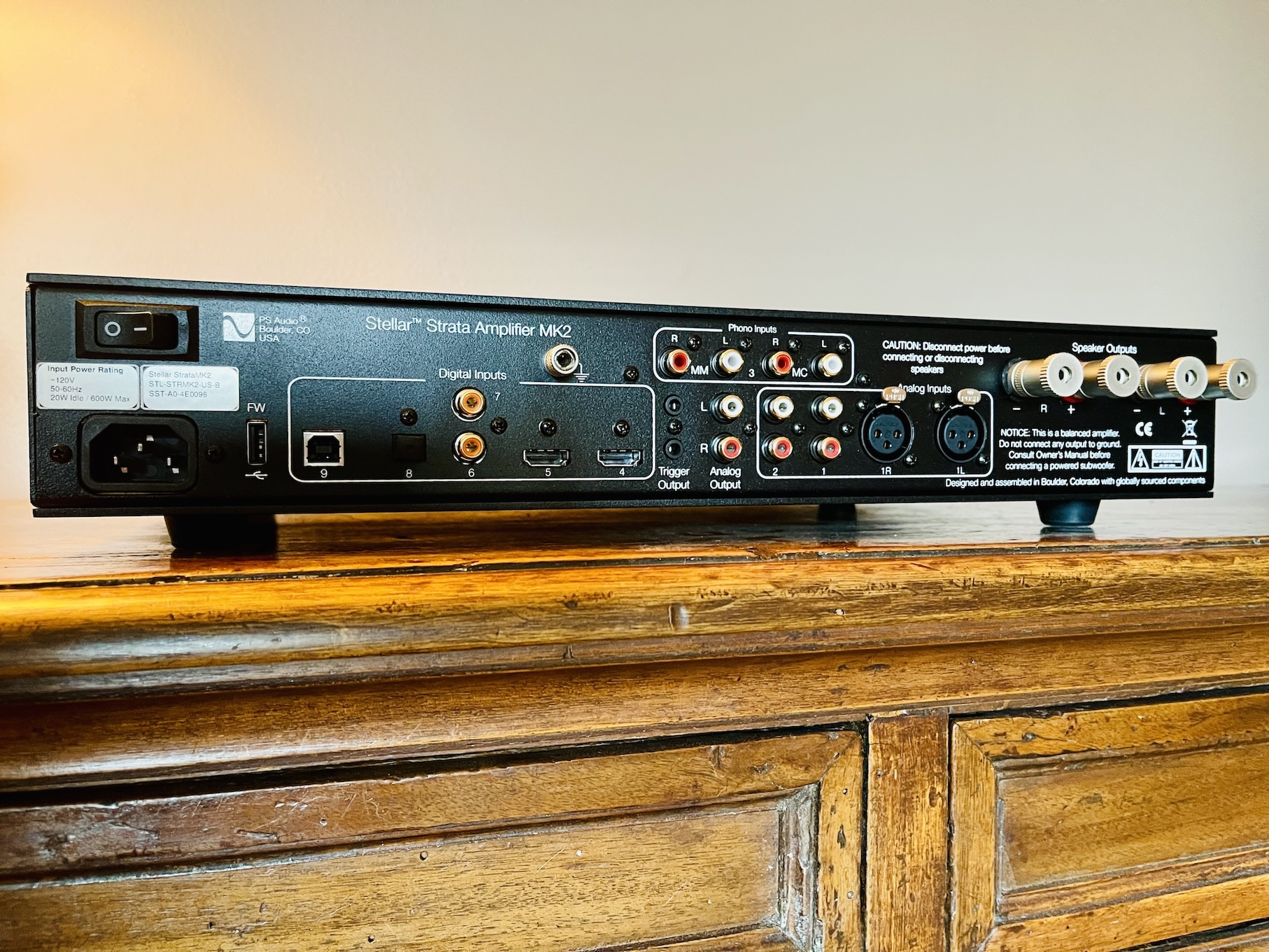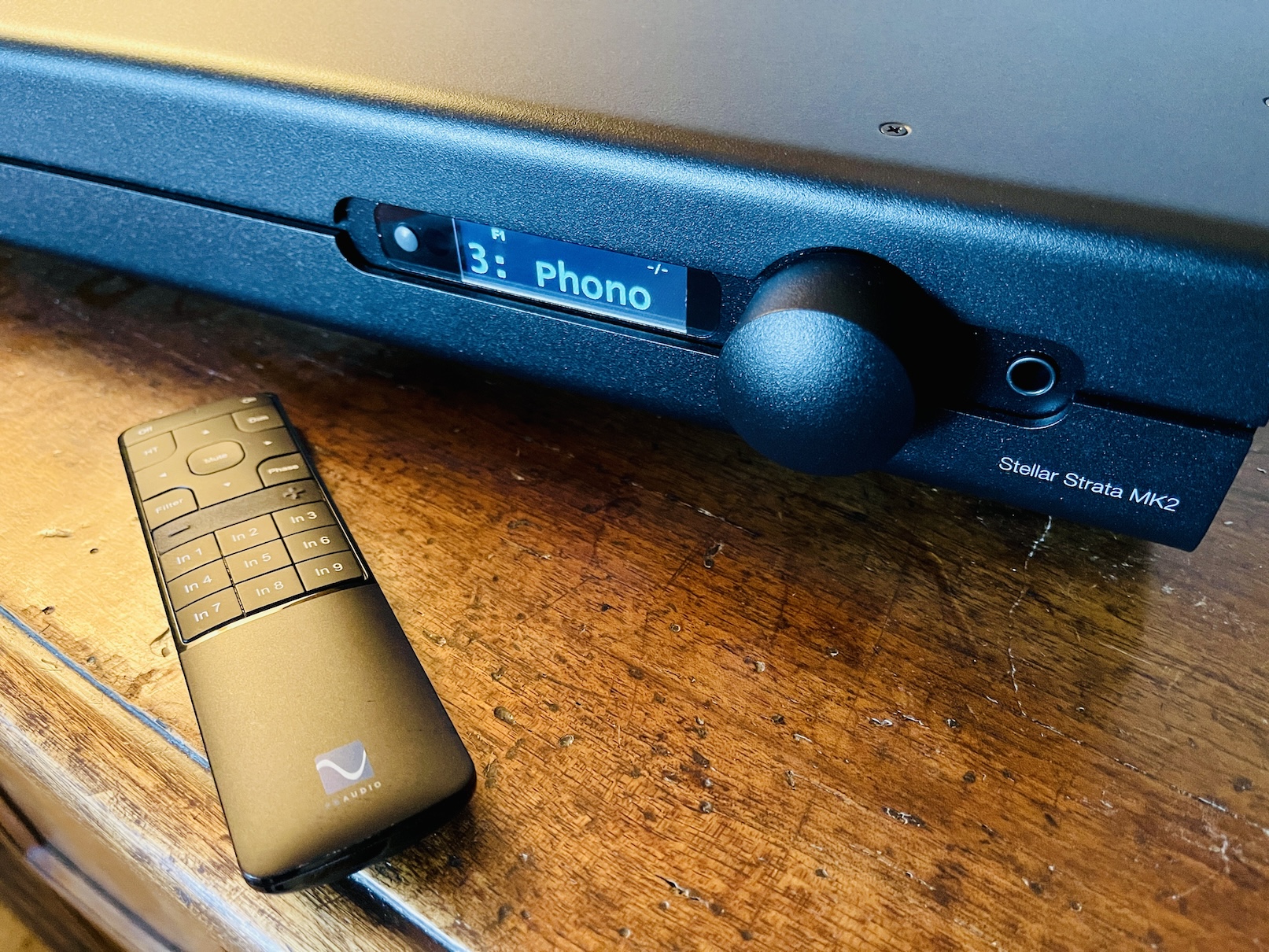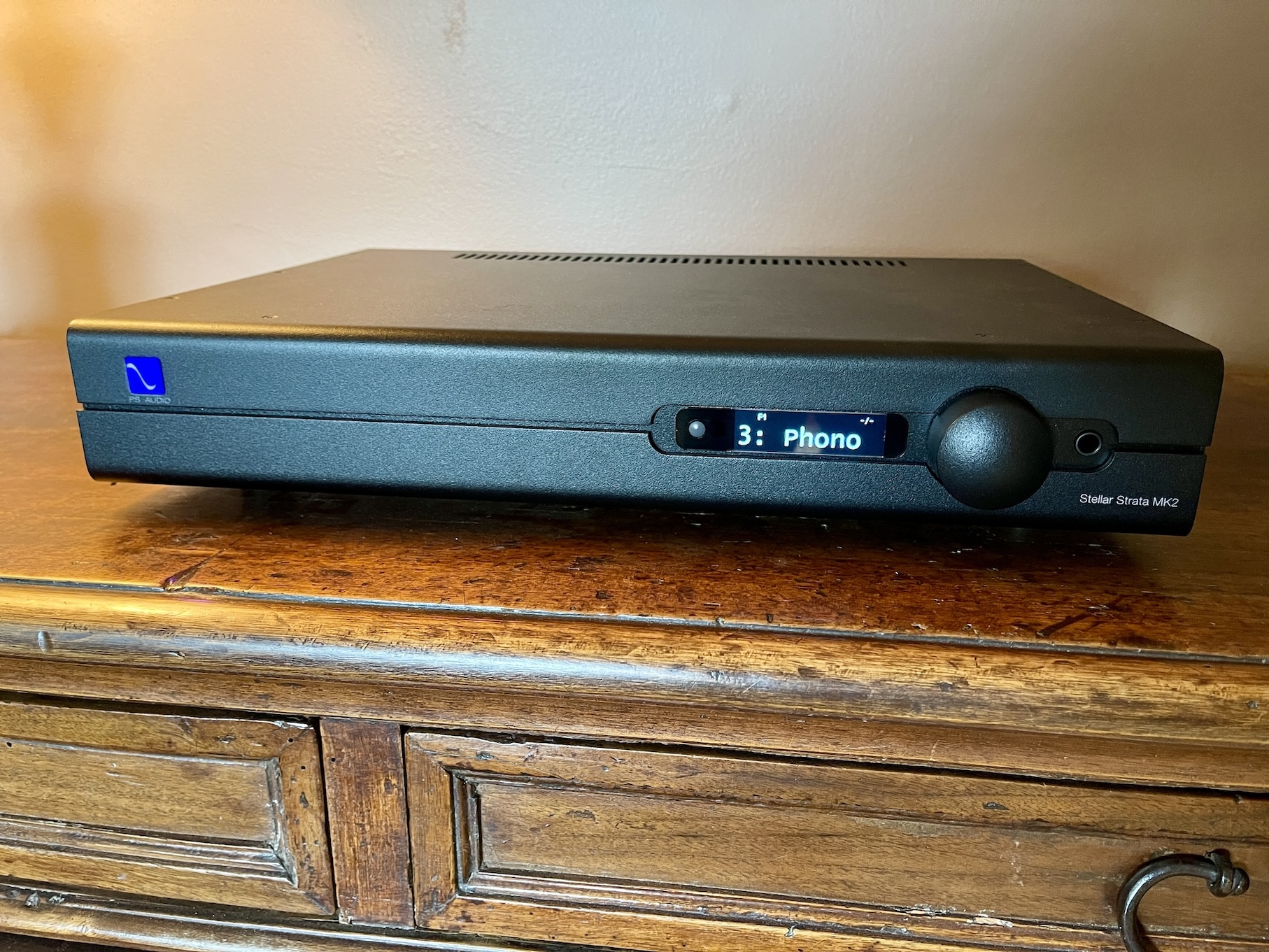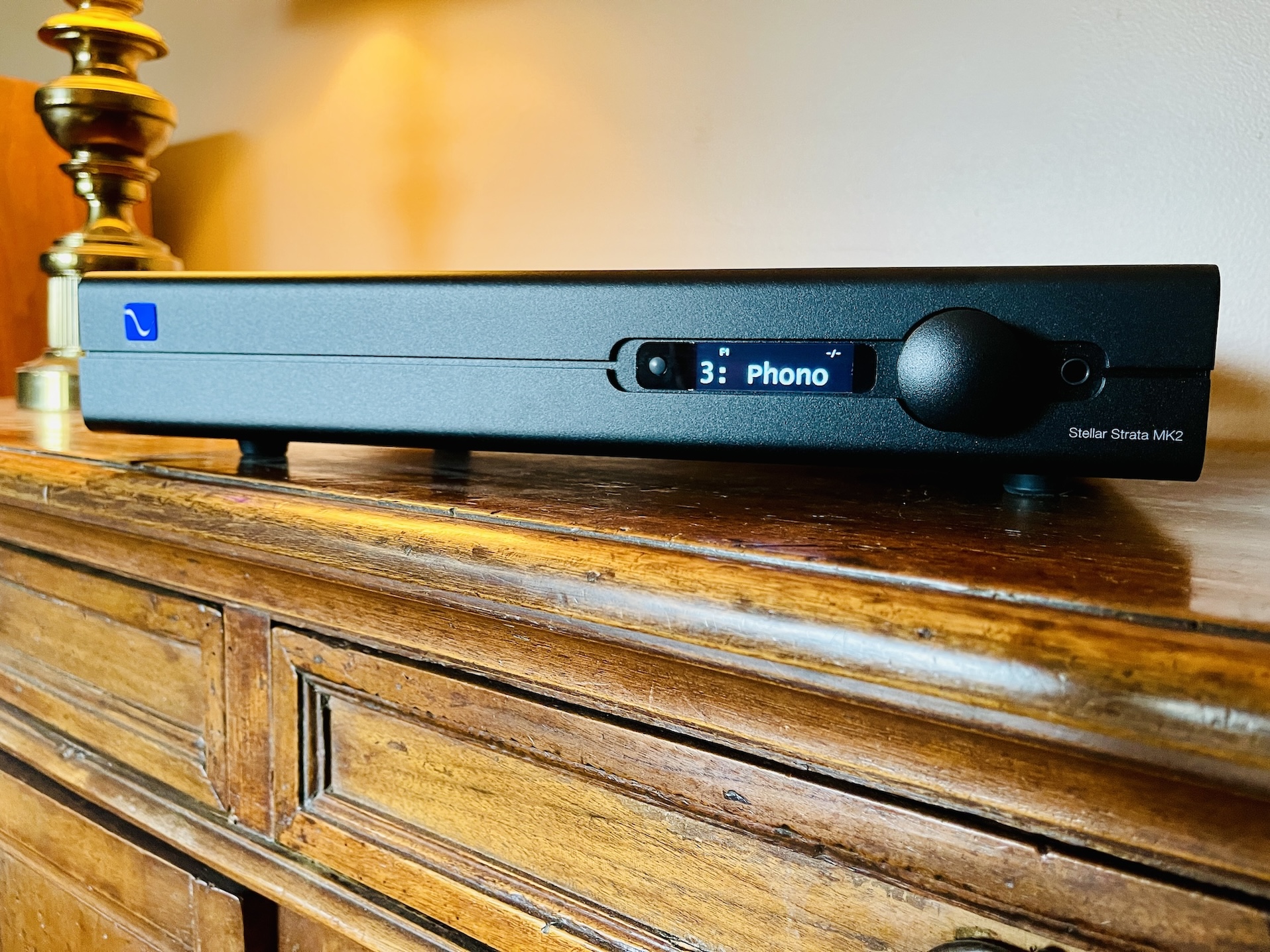PS Audio's Stellar Strata MK2
A No Nonsense Utility Integrated Amp With Exceptional Sound
The choice of a hi-fi component is an extraordinarily personal decision depending on the needs - and wants - of the consumer. Of course this is a bit of an obvious take, but in regards to every hi-fi review, it’s important to keep in mind: just because something is right for you, doesn’t mean that it’s the correct choice for someone else. So, perhaps the way to begin this article is by readers taking a personal inventory of what they want out of a hifi component. Maybe it’s also important to ask what you really need. What do you look for when you make a decision about the next hi-fi gear to add to your collection? Is it compact? Is bigger better? What’s your listening space like? How important is the functional utility of the piece?
Did you take a few moments to meditate on that? Feel better now? I do!
I’ve always appreciated the do-it-all Swiss Army knife unit that can handle anything: a classic integrated amp. Particularly, I’m enamored by vintage integrated amps of yesterday produced by companies like Marantz, McIntosh, Pioneer...the heavyweight champs. Enough power to provide headroom, thrust and umph is also on the list. Add an excellent built-in phono preamp and eye-pleasing aesthetics and I’m there. While I’m not averse to products that are manufactured overseas, I appreciate a unit produced in America.
That’s why The PS Audio Stellar Strata MK2 caught my interest. It’s a class A balanced analog integrated amplifier with DAC sporting a 150-watt per channel output. The unit’s literature notes a “high current output stage” and "high current Class A hybrid output stage” and so I inquired as to the source of this power and if an ICE module was utilized. The response from PS Audio was, “Yes, we are using an ICE module for the power supply and output stage.” “However,” they further clarified, “the class A rating that is mentioned in the literature is regarding the linear gain stage/ preamp stage.”
For vinyl lovers, there is a MC/MM phono stage (limited MC loading @100 ohms). One of the proprietary features of the unit is what PS Audio refers to as their trademarked Gain Cell technology (GainCell) which was created by the company’s founder, Paul McGowan. The circuit varies the preamplifier section's gain based upon the volume control setting as opposed to merely being an attenuator.
Weighing in at 21 pounds, it’s a hefty unit. The choice of aesthetics is certainly minimalist with a passing glance toward a retro vibe. That being said, the information screen - which mostly shares info about the volume level - exudes a sleek 21st century design. Gratefully, I was given the choice between auditioning silver or black and opted for the black option as the silver finish appears a bit too space age for my tastes. The unit was designed and assembled in Boulder, Colorado albeit with globally sourced components.
Before we get too far into my listening impressions, I’ll share a few more important specs though you can fully assess the intricate details of the unit on the PS Audio website. Aside from the phono channel there are 3 other analog inputs: 2 stereo RCAs and 1 stereo XLR. As far as digital inputs are concerned, you can expect 2 12S inputs, 2 coax, 1 optical, and 1 USB. Mostly, my time with the unit focused on its phono input though I used the unbalanced RCA output to create some vinyl transcriptions. A class A headphone amp output and the ability to conduct firmware updates complete the package.

I did not realize the unit included a remote control, so that addition was a pleasant surprise. Upon installing the included batteries into the remote, I was disappointed at the build quality of the handheld device. The battery compartment was difficult to slide open and the remote’s lightweight plastic and silk screened PS Audio insignia left me questioning its durability. The remote held up fine with my usage, but I would not be surprised if the lettering faded with moderate use. Truth be told, I may have dropped the remote on my tile floor once or twice, wincing as it floated down. I was concerned it was toast, but the remote held strong during its time with me.

All of the input jacks appeared sturdy and well-made and accepted banana plugs or could be unscrewed to accept bare speaker wire, old-school style. In this case, I used the PS Stellar Strata MK2 with my JBL L100 Classics. With the loudspeaker’s 90 dbs of sensitivity and power handling of up to 200 watts into 4 ohms, I was convinced this was an appropriate match to hear what the Stellar Strata was all about.
The first record I played through the unit was Quincy Jones’ Quincy’s Got a Brand New Bag (Mercury Records – 61063). My immediate impression was that the sound was much clearer then my usual set up and offered unmistakably more detail with a wider - and higher - soundstage. This particular album showcased a quick example of the high frequencies, never did they become screechy or unpleasant. Paired with the Ortofon Black 2M, however, a listener will no doubt receive transparent detail, warts and all. Be ready to look into the mirror and be honest with yourself about your source material when exploring the Stellar Strata MK2.
To sample something modern, I turned to a test pressing of Nickodemus’s latest album, titled Soul and Science (Wonderwheel Recordings - WONDERLP 61) and began with the title track on side two. I expected more bass response with my L 100s, but once I settled into the soundscape, I appreciated the enhanced detail that meshed with bass frequencies that were not overbearing or distracting. The song’s high frequency percussive elements performed well and included recurring horns and vocals. At this point in my time with the Stellar Strata, I was further convinced of one of the unit's strengths: it was primed to offer a detailed and accurate view of the material that it is fed. Which - fortunately - coincided well with the other components working in tandem with it.
The second track on Side B is titled “The Shadow Thief” and it’s a song I’ve enjoyed and played on the FM radio waves over the last year. Listening to it through this unit definitely revealed some elements to the song's character that I’d missed in the past. While not overbearing, the bass was thick, solid, taut and effortlessly locked into the groove that played off of the percussionist’s cymbals. I like this song and the Stellar Strata helped me to remember why.
In preparation for an interview with Andy Summers, I revisited a selection of albums gracing his guitar playing. In particular, I searched for his recordings that existed outside of The Police canon, reminded that he performed on Sting’s “Be Still My Beating Heart” from 1987’s Nothing Like the Sun album. Again, I was surprised - and pleasantly treated - to high levels of detail on this original pressing of Sting’s second solo release. It’s the little things, right? In this case, it was small percussive nuances. When shakers and other seemingly minor sonic elements were heard through the lens of the Stellar Strata they were larger, clearer, and more focused.
I quickly broke my “no Police” rule and threw on an original pressing of 1979’s Regatta de Blanc which bestowed cinematic amounts of space and excellent instrumental separation, most notably on the beginning of “Walking On the Moon”. Summer’s guitar chords gently hung in the air as though they were suspended by the Moon's gravitational pull. Listening on the Stellar Strata brilliantly showcases a trio like The Police. Copeland‘s high hat work, Sting’s solid bass lines, and Summer’s 6 string landscapes were appreciated simultaneously, but also as a whole.
The unit’s volume control is extremely nuanced. There is plenty of range available for one to find their preferred volume setting, perhaps a bit too much. I often found myself second-guessing my muscle memory about how much to twist the knob to achieve volume perfection. There was no shocking surprise by moving the volume control too quickly, there’s plenty of room to dial in your ideal sound level.
Much of my listening is done at low volume levels and occasionally - in those quieter regions - the Strata lost a little of its gutsiness. Or, maybe that was the result of the power-hungry JBLs. But, it’s tempered by the fact that the unit never produced sound that was fatiguing or unpleasant, even at higher volume levels and over extended periods of listening.
The digital numerical display shows the volume limits of 0 to 100. I found a sweet spot somewhere between 40 and 60 with low level listening being around 30. It’s considerate that the unit always reverts back to the 25 volume level after it’s been turned off. This removes the possibility that you’ll blast yourself out of your seat in case you’ve forgotten that you were cracking the volume during last night’s spinning session.
While most of my time with the Stellar Strata was relegated to putting its phono capabilities through their paces, I also explored a few digital sources. Recently, I was lucky to purchase a minty Japanese copy of Donald Fagen’s, The Nightfly on vinyl. I hope one day to add a copy of MFSL’s UltraDisc One-Step to my collection, but until then I’m happy to have this Japanese copy. So, I was surprised when only a week after finding the Japanese copy, I stumbled upon a CD pressing of the album that I’d never seen before: a recentish reissue from the E.U.(075992369626). So, why not give it a spin through the Strata? What I heard was incredibly balanced and neutral, Elliot Scheiner’s mix shined in all of its glory. In fact, it occurred to me that this presentation would suffice for constructing a mix in the studio: its presentation was honest and full of detail and space. However, this soundscape felt smaller than my vinyl counterpart to the album which was excitingly large in scale. My favorite track, “The Goodbye Look” exhibited the fabulous fusion of the acoustic and digital line that The Nightfly so successfully walks.
And now for something completely different, I thought as I cued up a 1984 Japanese CD reissue of Huguette Dreyfus’ 1977 album, J.S. Bach Works for Harpsichord (Denon – 38C37-7233). For this release, I switched to my vintage KLH Model Seventeen loudspeakers. I found the mic placement on Dreyfus’ harpsichord difficult to picture, but the presentation was thoughtful and intricate. Of course, bass on an album such as this won’t offer a wow factor. However, the midrange provided plenty of humanness and complimented the harpsichord's inherent higher frequencies.
Particularly arresting was Dreyfus’ rendering of the Andante movement from “Concerto in F Major, BWV971”. That track in particular emphasized many of the rhythm and timing qualities that I experienced with the unit. While that composition has a lower tempo than the works preceding it, there was an unusual evenness that allowed for particularly contemplative emotional processing. Such a great showcase was this CD that I was reminded of my fondness for early CD pressings of classical music, especially ones from overseas.
I also tried out my now - quickly becoming ancient - Google Chromecast Audio which supports FLAC and high-resolution streams up to 24-bit / 96 KHz. Through Quobuz I streamed Seun Kuti’s newest release into the unit: Heavier Yet (Lays The Crownless Head). Bass was notably energetic, but not overbearing or overly-pronounced. As on The Nightfly, it supported the song and the album’s hypnotically addictive afrobeat groove.
The handy optical connection provided excellent digital sound which I preferred to the RCA inputs. The CD that I auditioned through that input was Cake’s 2004 release, Pressure Chief. Again, soundstage was incredibly detailed adding plenty of character to John McCrae‘s unique vocals and left heaps of space available for the stable imaging of the mix to accurately present itself. The KLH’s offered a surprising amount of modern bass, but tempered their limitations with excellent midrange especially on the track, “No Phone”.
To test out all of the other tools that this all-in-one unit offers, I plugged in a pair of my Sony MDR-7506 headphones. Freshly pressed from Music on Vinyl in the Netherlands, I received a recent reissue of the Godfather III soundtrack. However, before unsealing the vinyl package (to be held for future review) I decided to give my original CD version a run through the Strata. Recorded and mixed by Joel W. Moss and mastered by Bernie Grundman, I was curious what I would find.
With headphones, I experienced an interesting function of the Stellar Strata. Using the headphones during “Marcia Religioso” seemed the right volume at around 50. However, with the speakers unplugged, the unit automatically deducted 20 points from the volume level: making the output in to the speakers 30. No matter what level the ‘phones were on (maxing out at 60), when the jack came out, the speaker volume simultaneously switched to 30. A welcome safety measure.
On "To Each His Own," Al Martino’s 1990 era vocals appeared smooth and steady through the ‘phones. This time around, however, I noted a bit of vulnerability in Martino’s voice that I’d never caught before. Rather than an impediment, it added an endearingly tender element of poignant warmth and nuance. Couple this with the arrangement’s mandolin and accordion and I felt transported to a catering hall somewhere in Queens. Now, where did I put my Chianti?
I found that playing my favorite track - “Sicilian Medley: Va Pensiero / Mazurka (Alla Siciliana) / Dana Tarantella” - through the ‘phones was at a reasonable volume at 60. For me, it was just right, but I can imagine that some folks might want to push those eardrums just a bit more. Your mileage may vary.
Back to vinyl: the final test of the integrated amp came after a recent purchase of an original Specialty Records pressing of Metallica‘s 1986 thrash metal masterpiece, Master of Puppets. Having never heard the album on vinyl before, I wasn’t sure what to expect, but something about the PS unit made these tracks sound new and fresh to my ears.
The soundstage was enormous and Hetfield’s chugging rhythm guitar didn’t blur and mush as it can on digital versions of the band’s catalog. Instead, it was tight and defined, adding power to an already brawny rock band. Hetfield’s vocals slid down the frozen side of a Norwegian mountain in the middle of a midnight blizzard. OK, maybe there’s a bit of hyperbole there, but James’ vocals did present as legendarily tall and as holographic as an ancient Nordic ghost story.
Metallica’s albums are not known for their copious bass tones. Again, the source is what the source is. Bass aside, Ulrich’s kick drum thump ended up straight inside of my chest.
Again, here, the rhythm and timing of the music was thoughtful, purposeful. The Stellar Strata MK2 also has a dry quality: which - in Metallica’s case - was an exceedingly positive characteristic. This combination of traits ensured there was no excessive smear to muddy up the busy soloing, or impair the music’s unexpected tempo changes.

Does the Stella Strata MK2 meet my Swiss Army knife expectations? Absolutely. In fact, it exceeded it; I left it leaving more to be explored. Any consumer looking for a no nonsense, high powered integrated amp that is well-suited to phono playback ought to consider this unit. It might also be perfect for the high-end audiophile enthusiast who already has a tremendously high-priced - and expansive - system, but who may desire a simple setup in another room, office, or home. And, perhaps the most appealing part is that the Stellar Strata MK2 is offered at $3499.00.
Does it sound like PS Audio’s Stellar Strata MK2 meets the expectations you have out of a hi-fi unit? If it does, know that you’ll receive more than a great integrated amp, you’ll purchase an item that doesn’t only offer the excellent sonics as described above but has important utility when it comes to simplifying great sound. In fact, like many of the world’s greatest products, the Stella Strata MK2 may be one of the more successful marriages of functional utility and performance.
Specifications
Input Selection 9 total: 2 analog, 6 digital, 1 Phono
Volume Control 0-100 (80 dB total range)
Balance Control 12dB each direction in 1/4dB steps
Fixed Volume Mode Analog2: adjustable in setup to any level
Phase Control Digital sources only
Filter Control 3 selectable digital filters (PCM digital sources only)
Input Trim Gain adjustable per input +/-10dB
Headphone Trim Gain adjustable +/-10dB relative to speaker level
Analog Inputs:
Input Separation >85dB
Input Impedance 47KΩ (unbalanced); 100KΩ (balanced)
Maximum Input Level >16 VRMS
Phono Input:
Cartridge/Type MM MC
Gain 40dB 57dB
Loading 100pF/47kΩ 470pF/100Ω
THD+N .001% @ 5mV input .003% @1mV inpu
Manufacturer Information
PS Audio® Inc.
800-PSAUDIO
4865 Sterling Drive
Boulder, Colorado 80301











































